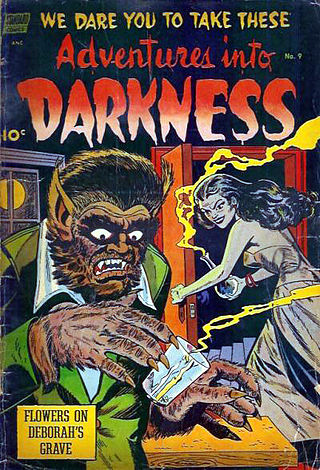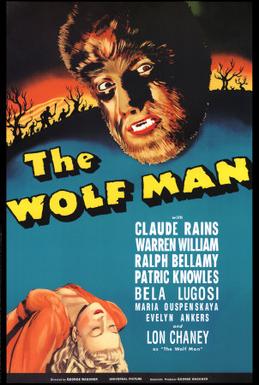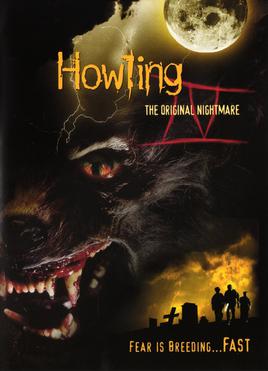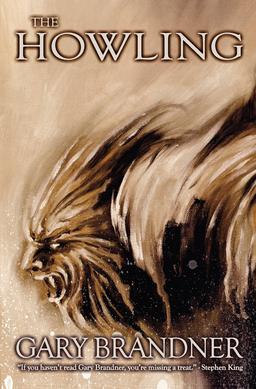
In folklore, a werewolf, or occasionally lycanthrope, is an individual that can shapeshift into a wolf, either purposely or after being placed under a curse or affliction with the transformations occurring on the night of a full moon. Early sources for belief in this ability or affliction, called lycanthropy, are Petronius (27–66) and Gervase of Tilbury (1150–1228).

Werewolf fiction denotes the portrayal of werewolves and other shapeshifting therianthropes, in the media of literature, drama, film, games and music. Werewolf literature includes folklore, legend, saga, fairy tales, Gothic and horror fiction, fantasy fiction and poetry. Such stories may be supernatural, symbolic or allegorical. A classic American cinematic example of the theme is The Wolf Man (1941) which in later films joins with the Frankenstein Monster and Count Dracula as one of the three famous icons of modern day horror. However, werewolf fiction is an exceptionally diverse genre, with ancient folkloric roots and manifold modern re-interpretations.

The Wolf Man is a 1941 American horror film written by Curt Siodmak and produced and directed by George Waggner. The film stars Lon Chaney Jr. in the title role. Claude Rains, Warren William, Ralph Bellamy, Patric Knowles, Bela Lugosi, Evelyn Ankers, and Maria Ouspenskaya star in supporting roles. The title character has had a great deal of influence on Hollywood's depictions of the legend of the werewolf. The film is the second Universal Pictures werewolf film, preceded six years earlier by the less commercially successful Werewolf of London (1935). This film is part of the Universal Monsters movies and is of great cinematic acclaim for its production.

Cycle of the Werewolf is a short horror novel by American writer Stephen King, featuring illustrations by comic-book artist Bernie Wrightson. Each chapter is a short story unto itself. It tells the story of a werewolf haunting a small town as the moon turns full once every month. It was published as a limited-edition hardcover in 1983 by Land of Enchantment, and in 1985 as a mass-market trade paperback by Signet. King also wrote the screenplay for its film adaptation, Silver Bullet (1985). It is King's shortest novel to date at 127 pages, which makes it technically a novella.

Bitten is a fantasy novel by Canadian writer Kelley Armstrong, published in 2001. It is the first book in the Women of the Otherworld series, and her first novel.

The Howling is a 1981 American horror film directed by Joe Dante. It is based on the novel of the same name by Gary Brandner. The film stars Dee Wallace, Patrick Macnee, Dennis Dugan, and Robert Picardo.

Howling III is a 1987 Australian horror film and the sequel to The Howling, directed by Philippe Mora and filmed on location in and around Sydney, Australia. Starring Barry Otto, Imogen Annesley and Max Fairchild, Howling III is the only PG-13 rated entry in the Howling film series and also the last film in the series to be released theatrically. In this sequel, werewolves have evolved, with females having marsupial-like pouches to nurse their young. Scientists attempt to study them, while soldiers try to track and kill them in the Australian Outback.

Howling II: Your Sister Is a Werewolf is a 1985 American horror film directed by Philippe Mora and direct sequel to the 1981 film The Howling. The film stars horror film veteran Christopher Lee along with Reb Brown and Annie McEnroe as they try to defeat Sybil Danning's werewolf queen Stirba and stop a werewolf group's plans to conquer the world. Although Gary Brandner, author of The Howling novels, co-wrote the screenplay, the Howling II: Your Sister Is a Werewolf is largely unrelated to his 1979 novel The Howling II.

Howling IV: The Original Nightmare is a 1988 British direct-to-video horror film directed by John Hough from a screenplay by Freddie Rowe and Clive Turner. Starring Romy Windsor, Michael T. Weiss, Antony Hamilton, Susanne Severeid and Lamya Derval, The Original Nightmare is the fourth entry in the series of seven standalone films with loose continuity and is not so much a sequel but rather a more faithful adaptation of Gary Brandner's source novel The Howling (1977).

Howling VI: The Freaks is a 1991 British direct-to-video horror directed by Hope Perello, from the screenplay by Kevin Rock, starring Brendan Hughes, Bruce Payne, Michele Matheson, Sean Gregory Sullivan, and Carol Lynley. "The Freaks" is the sixth entry in the series of seven standalone films with a loose continuity.

Howling: New Moon Rising is a 1995 British direct-to-video comedy-horror film directed, produced, and written by Clive Turner, the seventh film in The Howling film series. The film reuses footage from the previous three sequels in the Howling series, and features characters from each film. The plot has a detective in the film uncover several clues that connect events of the latter part of the series. It was followed by The Howling: Reborn in 2011.

Werewolf of London is a 1935 horror film directed by Stuart Walker and starring Henry Hull as the titular werewolf. The supporting cast includes Warner Oland, Valerie Hobson, Lester Matthews, and Spring Byington. Jack Pierce, who is best known for creating the iconic makeup worn by Boris Karloff in the 1931 film Frankenstein, created the film's werewolf makeup. Produced by Universal Pictures, Werewolf of London was the first feature-length werewolf film.

Gary Phil Brandner was an American horror fiction author best known for his werewolf themed trilogy of novels, The Howling. The first book of the series was adapted loosely as a motion picture in 1981. Brandner's second and third Howling novels, published in 1979 and 1985 respectively, have no association with the film series, though he was involved with writing the screenplay for the second Howling film, Howling II: Your Sister Is a Werewolf. The fourth film of the Howling series, Howling IV: The Original Nightmare, is actually the closest adaptation of Brandner's original novel, though this too varies to some degree.

The Vampire by Night is a fictional character that appears in comic books published by Marvel Comics. She is the niece to Jack Russell and has the ability to shapeshift into either a werewolf or a vampiress between dusk and dawn.

The Howling II is a 1979 horror novel by Gary Brandner. It is the first of two sequels to his 1977 werewolf novel, The Howling. The novel was later republished under the alternative titles The Howling II: The Return and Return of the Howling.

The Howling III: Echoes is a 1985 horror novel by the American author Gary Brandner. It is the third and final entry in his Howling series of novels. Like its predecessor, The Howling II, the book has not been adapted for the screen and bears virtually no similarity to the Howling III film or any of the other films in The Howling series. Minor elements of the novel were used in the film Howling VI: The Freaks, though this idea was actually first seen in the 1975 British horror film Legend of the Werewolf.

The Howling: Reborn is a 2011 teen horror film directed by Joe Nimziki and starring Lindsey Shaw, Landon Liboiron and Ivana Miličević. It is the eighth film and a reboot of The Howling film series. The film was released on DVD on October 18, 2011.

Late Phases is a 2014 horror drama film by director Adrián García Bogliano and his first feature film in the English language. The film had its world premiere on March 9, 2014, at South by Southwest and stars Nick Damici as a blind war veteran that becomes the victim of a werewolf attack.

The Howling is an American werewolf-themed horror media franchise that includes three novels and eight films. The series began with the 1977 horror novel The Howling by Gary Brandner, which was in 1981 adapted into the film of the same name, directed by Joe Dante.

The legendary werewolves of Ossory, a kingdom of early medieval Ireland, are the subject of a number of accounts in medieval Irish, English and Norse works. The werewolves were said to have been the descendants of a legendary figure named Laignech Fáelad whose line gave rise to the kings of Ossory. The legends may have derived from the activities of warriors in ancient Ireland who were the subject of frequent literary comparisons to wolves, and who may have adopted lupine hairstyles or worn wolf-skins while they "went wolfing" and carried out raids.




















